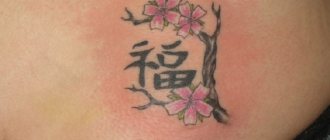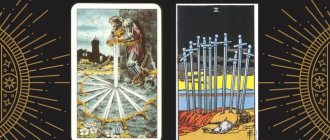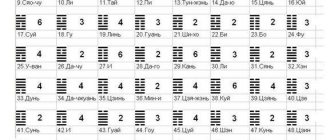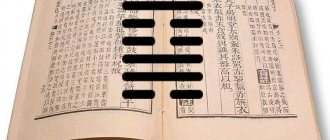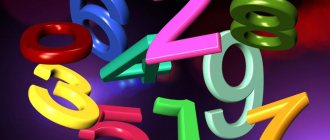One of the most ancient systems for predicting the future is the Book of I Ching, which came to us from the depths of centuries. In addition to the fact that this fortune telling is characterized by amazing accuracy, it is also a cultural monument of a great ancient civilization, the inventions of which we use to this day.
This section presents the interpretation of the hexagrams of the I Ching Book of Changes, and their interpretation with detailed decoding for various options for online fortune telling, as well as some texts from the book itself.
The worst hexagrams of the Book of Changes
It is impossible to name clearly negative symbols due to the difference in the interpretation of individual lines, but some of them are still the most unfavorable. Among these:
- Hexagram 3 Zhun;
- Hexagram 6 Sun;
- Hexagram 39 Jian.
But be careful, their interpretation can also have positive aspects.
On our website you can conduct fortune telling using the I Ching Book of Changes in any of the existing options, for example - Money Toad, Past and Future, Life according to Feng Shui, Love Book of Changes, as well as Yin-Yang and the I Ching Oracle. The ancient Chinese predictions collected on our website have a long history, their reliability and accuracy have been tested by time, so there is every reason to trust this method and apply it in practice. You can also predict the future yourself, using the interpretation of each hexagram and its description presented in this section.
Interpretation of hexagrams by image
| 3 | 4 | 5 | 6 | 7 | 8 | ||
| 9 | 10 | 11 | 12 | 13 | 14 | 15 | 16 |
| 17 | 18 | 19 | 20 | 21 | 22 | 23 | 24 |
| 25 | 26 | 27 | 28 | 29 | 30 | 31 | 32 |
| 33 | 34 | 35 | 36 | 37 | 38 | 39 | 40 |
| 41 | 42 | 43 | 44 | 45 | 46 | 47 | 48 |
| 49 | 50 | 51 | 52 | 53 | 54 | 55 | 56 |
| 57 | 58 | 59 | 60 | 61 | 62 | 63 | 64 |
Symbols and numbers of Vladimir Eremeev
Circular form of writing the I-Ching Hexagrams
Particular attention should be paid to the scientific publications of the academician of oriental studies of the USSR Academy of Sciences and the Russian Academy of Natural Sciences, Vladimir Evstigneevich Eremeev, who devoted most of his adult life to the study of the mathematical mysteries of the Book of Changes. He believed that Hexagrams are one of the most important characteristics of existence, elements of a certain cosmic code with the help of which all world realities are shaped and organized. All of Eremeev’s scientific publications were devoted to this topic, including the very first, published by him in 1983 in a closed scientific publication of the USSR Academy of Sciences.
The academician believed that the “numerology” of the I-Ching was in fact an imperfect part of a previously unknown ancient teaching, which had the character of a completely rational ideological and methodological body of knowledge that served the religious, socio-political and scientific activities of the ancient Chinese.
Throughout his adult life, Eremeev tried to prove an important thesis to the international scientific community: “We are witnesses to the beginning of a real transformation of the world. Advanced scientific discoveries in the field of quantum physics, particle physics, astrophysics, genetics, chemistry and biology are increasingly “lighting” society’s path to the Universe of a new Renaissance.”
Eremeev was absolutely sure that the world is now experiencing a central moment - globalization and globalistics, having fulfilled their mission, are passing the baton to a new phase of world development - cosmologization and humanitarian cosmology. He wrote: “Number expresses the structural integrity of things. Numbers make things knowable..."
At the suggestion of Eremeev, a number of scientists at the USSR Academy of Sciences actively studied the works of M. Schönberger on the amazing similarity of the structure of the arrangement of the I-Ching Hexagrams and the form of recording the structure of the Human Genetic Code.
Brief Biography of Academician of the USSR Academy of Sciences and Russian Academy of Natural Sciences V.E. Eremeeva
List of scientific works and publications by V.E. Eremeeva
V.E. Eremeev. Mechanics of Universal Interactions
V.E. Eremeev. Symbols and numbers of the “Book of Changes”
V.E. Eremeev. Astronomy of the Universe I-Ching
V.E. Eremeev. Theory of Psychosemiosis and Ancient Anthropocosmology
V.E. Eremeev. Time in ancient Chinese Arithmosemiotics
How to perform the ritual correctly
The traditional ritual begins with covering a small table with silk cloth, as well as 50 plant stems 25-50 cm long. After laying out the objects, you should light incense, sit facing south, bow three times and sit in a special position on your heels.
Then you need to squeeze fifty stems in your hands and carry them over the incense burner 3 times. Next, the stems are randomly divided into two bundles. In this case, they should all be held in both hands and taken out from the right hand with the same hand, one stem at a time, and then secured on the left hand in the area of the little finger and ring finger.
The original source containing a description of the technique of fortune telling according to the I Ching, Xi Qi Zhuani (I, 9), refers to yarrow stems.
To implement this ancient mantic technique (achilleomancy), you need 50 yarrow stems, which can be replaced with similar objects, for example, counting sticks or matches.
They are placed in a bunch on a table covered with a cloth, preferably silk, and one stem is immediately put aside with the right hand, no longer used, and the remaining 49 are divided in the center with both hands into two bunches. The left one is clamped in the left hand, and one stem is taken from the right one with the right hand and placed between the little finger and ring finger of the left hand.
Then, with the right hand, four stems are taken out from the left bunch. The remainder (1, 2, 3 or 4 stems) is placed between the ring and middle fingers of the left hand.
The stems counted out in fours are returned with the right hand to the left, and the right bunch is taken and four stems are removed from it with the left hand.
The remainder is placed between the middle and index fingers of the left hand.
In total, between the fingers of the left hand there can be 5 or 9 stems in the following combinations: 1 + 1 + 3, 1 + 2 + 2, 1 + 3 + 1, 1 + 4 + 4.
They are put aside
All remaining stems are tied back together with both hands into one bundle of 44 or 40 stems. The entire operation described above, called “change,” is repeated with it. As a result, between the fingers of the left hand there are 4 or 8 stems in the combinations: 1+1+2, 1+2+1, 1+3+4, 1+4+3. After they are laid, the remaining bunch may consist of 40, 36 or 32 stems.
This is followed by exactly the same third “change”, as a result of which the same combinations of stems are formed between the fingers of the left hand as in the second “change”.
After this three-step procedure, the remaining bunch may consist of 36, 32, 28 or 24 stems.
When divided by 4, the indicated amounts give respectively the numbers 9, 8, 7, 6, symbolizing the features of the hexagrams: 9 – “old yang”, 8 – “young yin”, 7 – “young yang”, 6 – “old yin”.
Having fixed the resulting trait, you should similarly make three more “changes” that will allow you to get a second trait, located above the first (lower). The entire six-stage construction of the hexagram involves 18 “changes.”
If the resulting hexagram consists of only “young” features, then only it and the text associated with it are considered further.
If among its features there is one or more “old” ones, then they are transformed into their opposite (yin - into yang, yang - into yin) and, in addition to the first, the secondary hexagram derived from it is considered in a similar way as expressing the tendency of the subsequent development of the situation, predicted in the first hexagram.
After the fortune telling has been completed, you need to bow to the ground three times again and collect all the equipment in a box.
Image
The situation of hexagram 44 Gou (Transversation) resembles 20 Guan (Observation). In the latter, the wind blows above the ground, and in the 44th it spreads under the sky. That is, in general it blows everywhere. In the 20th hexagram, the wind blows on the earth and displays the ruler who is studying the situation in his kingdom. And in the 44th hexagram it blows from above and describes the influence that the ruler exerts at the expense of his subjects. Heaven is distant from earthly things, but starts movement due to the wind. Likewise, the ruler is removed from the people, but moves them through orders.
Classic fortune telling method
In this method, only 50 objects are attracted.
Since one stem is removed at the first stage of the ritual, in fact the rituals are performed not with 50, but with 40 things. Trigrams can be placed in either a square or a round table. It all depends on what you are comfortable with. In the simplified version, the ritual itself ends after the construction of one hexagram, but the traditional version still has “young” and “old” features. Six is old, seven is young, eight is old, nine is young. When even one “old” line falls out in the ritual, a new hexagram should be created, where the specified line experiences “rejuvenation”, being replaced by the opposite one. The first hexagram is current affairs, the second is future events.
In some cases, only those aphorisms that were associated with the “old” dash are taken into account, which undergoes the so-called “rejuvenation”. In such situations, the second hexagram is no longer built.
In addition to all of the above, the hexagram can be used to highlight the internal hexagram, which has the Chinese name “hu gua”. The name is not accidental, because such fortune telling occurs with the help of four internal features - from the second to the fifth, on the basis of which a completely new hexagram is built.
A very important point is to study how the various traits interact with each other in the hexagram.
Main types:
• “consonance” is the first and fourth, second and fifth (middle), third and sixth features, best when there is a combination of • “yin” and “yang”, this is the connection that is called consonant, but if two “yin” coincide or two “yang”, then this is not very good, such a connection is called “dissonant”;
• “neighborhood” - a combination of the first and second, second and third features, further by analogy, here also the best comparison is considered to be a combination of unlike features, which is called “convergence”;
• in the case when the “yang” line is above the “yin” - this is “support”;
• if the opposite happens, then this is “saddle”;
• there is a similar hieroglyph, which means that “yin” is under “yang”, but its meaning is different – “acceptance”.
To correctly understand the meaning of all “yao” you need to count them from bottom to top, although this goes against the way the Chinese read in principle.
The first feature is called “initial”, while the last one is called “upper”. All other “yao” get their name in accordance with their number - 2, 3, 4.
Hexagrams of the I Ching and the Genetic Code
The works of J. Watson and F. Crick and along with them the X-ray diffraction studies of M. Wilkins revealed the structure of DNA to the world. It is a long chain of repeating sequences: sugar - phosphate - sugar - phosphate, etc.
Tabular form of recording the structure of the human genetic code
The alphabet of our genetic code consists of four chemical bases (nucleotides) - Adenine (A), Guanine (G), Cytosine (C) and Thymine (T), grouped three in each of the 64 codons of the genetic code. In the double helical structure of DNA, they intersect with each other and enter into a binary (i.e., double) bond, with each element having its own rigidly established pair.
Circular forms of recording the Genetic Code and Hexagrams of the I-Ching
Thus, any hereditary information is written in a language containing only four letters. Each of the chemical groups represents an amino acid and forms a so-called codon. There are 64 codons in our genetic code, just like there are 64 hexagrams in the I Ching.
Correspondence between the structure of the I-Ching Hexagrams and nucleotide sequences
In 1973, German physician Dr. Martin Schonberger discovered striking similarities between the genetic code pattern and the hexagram pattern of the I Ching. He described these observations in detail in his book.
Translation of the binary form of writing the I-Ching Hexagrams into ternary
The idea of the I Ching as a secret scheme containing the genetic code was even approved by the famous lama Anagarika Govinda, who wrote a substantial preface to Schonberger’s research. In fact, a number of prominent specialists in the field of mathematics (since much of the research was based on purely mathematical calculations), biology, and physics also agreed with Schonberger’s idea. Schonberger came to the conclusion that both ciphers are identical to each other. These are simply different systems in which the same formula of the Universe is encoded.
In 1990, the American Katya Holmes published her book, in which she brought Schonberger’s theory to perfection, eliminating some of the inaccuracies and minor errors that the German scientist had made.
Russian scientist and researcher I-Ching S.V. Petukhov released several detailed analytical articles on the topic of correspondence between the structure of Hexagrams and the genetic code, making several more incredible conclusions and observations from this theory.
Dr. Martin Schonberger. The I-Ching & the Genetic code (1973)
S.V. Petukhov. Analysis of I-Ching Hexagrams and Genetic Code
S.V. Petukhov. Genetic Programming I Ching
S.V. Petukhov. Noise immunity of the Genetic code
S.V. Petukhov. Genetic resonance of the I Ching
The meaning of the trigram combination
Each hexagram is a combination of a pair of trigrams (upper and lower). Let's look at the meaning for hexagram 44.
Heaven in the wind
Hexagram 44 Gou (Transect) represents the wind that comes from the heavens and disturbs the world located on earth. The heavens are famous for their height and power, because they are fixed above us and influence through the wind. Many ancient myths indicate that the heavens control us from above through the wind.
In principle, any wind should be considered as a factor of change. He starts a movement in the world with a specific purpose. The starting point is the heavens, and the direction is tian dao, which in ancient China was once called the “heavenly way.” The wind demonstrates heavenly intentions or, according to Taoism, the path of nature, which is indifferent to human will and does not depend on it.
It seems that this is an accident, but there was nothing like this in the cosmology of Ancient China. Any event has a specific purpose: human or heavenly. In any case, the hexagram reflects processes that are beyond our control.
Therefore, it should be taken as a warning. Heaven seems to be hinting that it is important to pay more attention when choosing a path. In the end, the wind comes as close to the heavens as earthly creatures can hope for. The ruler expresses his opinion to his subjects and it is better to listen to him before doing anything.
Lines in hexagram 44
Bottom line
If an extra element is inside, it should be checked immediately. Constant checking will avoid negative influence. If you allow everything to develop as usual and do not interfere, then misfortune cannot be avoided. Even if the problem seems minor, you cannot ignore it. A thin and young pig may seem harmless. However, she is capable of becoming angry when she is satiated and increases her strength. True nature will awaken if it is not curbed.
Second line
The lower element cannot be overcome by violence, but can be overcome through gentle control. In this case, you don’t have to worry and evil will not be able to harm you. But it is extremely important to be careful not to allow him to come into contact with those above, otherwise he will become free and begin to act evil with impunity.
Third line
The temptation is great to become part of the evil element. A dangerous situation is developing, but the good news is that circumstances are preventing this. Because of this, a person begins to behave indecisively. If you clearly understand the danger of the current situation, you will be able to prevent catastrophic mistakes.
Fourth line
You have to tolerate insignificant individuals so that they remain in a good and upbeat mood. Then you can use them if necessary. If we push them away or do not meet and make concessions in time, they will turn away from us and will not come to our aid when we need them. But the blame falls entirely on our shoulders.
Fifth line
The melon symbolizes the principle of darkness. It is sweet, but easily spoiled, so it is protected by a covering of willow leaves. In such a situation, a strong, superior and balanced person must tolerate and protect his subordinates. He has clear order and inner beauty, but does not rely on it.
He does not bother his subordinates with ostentatious appearances or tedious lectures. No, he gives them complete freedom, relying only on their inner strength, morality and honesty. And so! Fate smiles. Subordinates begin to voluntarily behave conscientiously and completely obey.
Top line
When a person withdraws from the world, the inner turmoil becomes unbearable. There are a large number of people who, in noble pride, remain aloof from everything base and sharply reject if they encounter something similar. But when surrounded by such people they are not perceived, because they seem proud and distant. But they don’t care because they rarely have contact with the real world. They are calm about hostility from society.
Content
“The Book of Changes” contains 64 graphic symbols, consisting of 6 horizontally drawn “yao” lines.
It is these features that are called hexagrams. Which is translated from Greek as “six features.” Each hexagram not only contains characteristics of various life situations, but also takes into account its further course. 64 characters of the Book of Changes:
The “yao” contained in the hexagram are of two types: interrupted - yin, whole - yang. Solid "yao" are designated by the number 9, and are white in color, symbolizing mobility, tension and clarity. Interrupted “yao” are designated by the number six and are black, symbolizing darkness, weakness, pliability and passivity.
When the necessary rituals have been carried out, consisting of complex actions with all kinds of objects, such as twigs, coins, yarrow stems, and many others, a special hexagram is constructed, according to which a further search for answers is carried out, written in special chapters of the book in poetic form. In some cases, in addition to the main hexagram, it is possible to construct one or two “yaos” arising from this hexagram.

